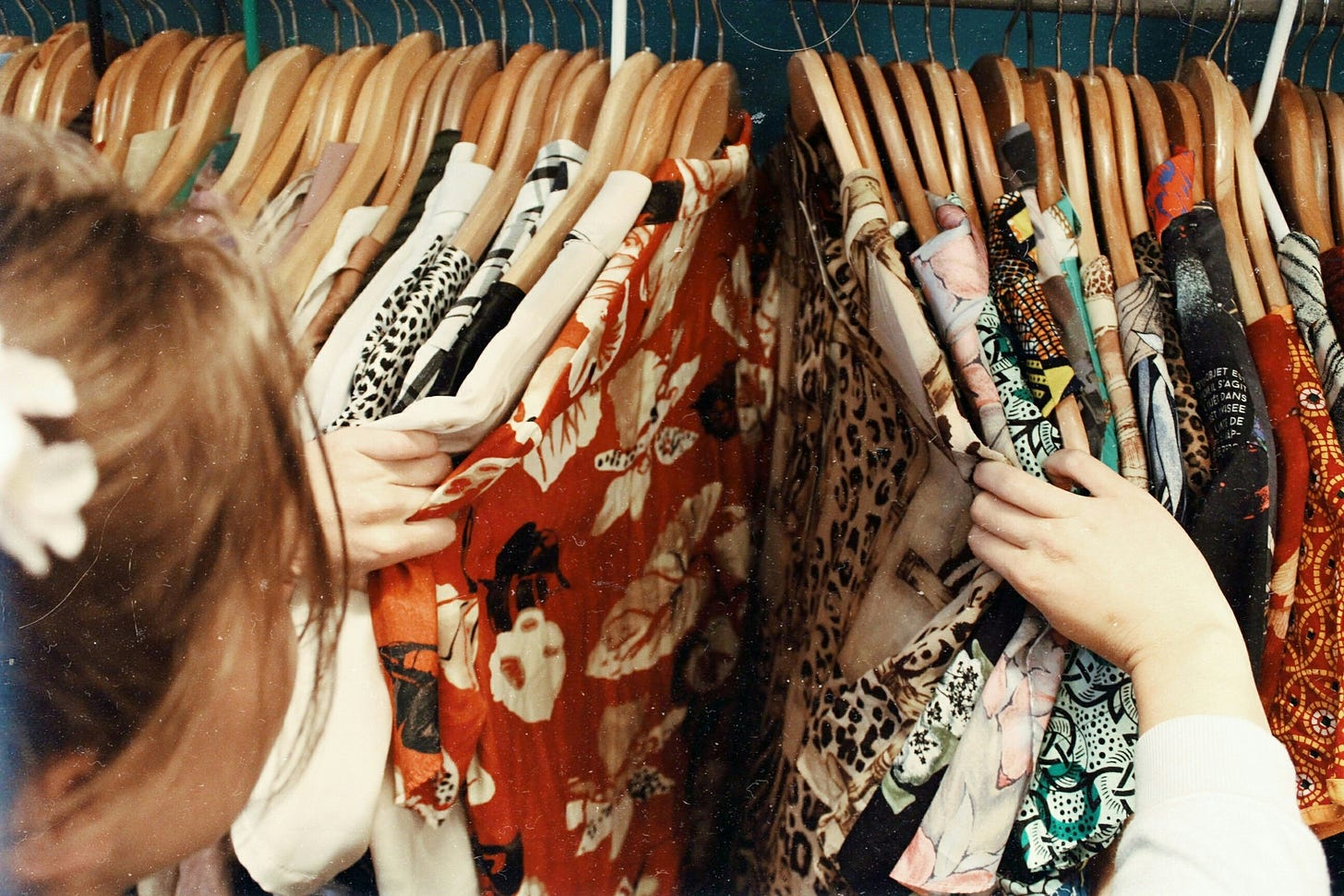the secondhand clothing trend is leaving big boys behind.
It’s tough out there for a fat fashion enby.
Queering the Burbs is a twice-weekly distillation of pop culture, politics and queerness written by Joe Erbentraut. If you like what you see, please consider subscribing (many posts are free!), liking or sharing this piece. Order Joe’s new zine and check out his new merch at the Queering the Burbs virtual gift shop.

At the beginning of every year I tense up waiting for the moment to come, and without fail it drops like a bomb: Canva design after Canva design on my Instagram feed calls on us lowly consumers to please, please, please start buying more clothes secondhand and to resist the urge of buying “fast fashion” online.
This year, the plea arrived right on cue, with an additional timely element: As one viral Instagram post puts it, shopping secondhand for clothing can be an integral part of opting out of the economy altogether, sending a message to the political powers that be that we will no longer be pawns in this game so clearly rigged for our billionaire peers.
Of course, I am all for this push in principle. I think that many fast-fashion brands like Temu and Shein are morally and ethically abhorrent. Of course, in an ideal world I’d be buying more clothing (secondhand or otherwise) entirely from either local small businesses or online from businesses who are adhering to sustainable practices. But, for various reasons, this is an extremely difficult ask for people like me.
In my teen years, when I was first developing my sense of personal style, I was a Goodwill girl. In high school, I almost exclusively wore a Seth Cohen-inspired uniform of flared polyester pants and western shirts that someone’s grandpa had died in—typically over top of a band t-shirt of one variety or another. In college, I dug through bins to buy clothes by the pound from a local store just off campus. And after graduating into the 2008 recession, most of my “new” clothes I was wearing at the time came from thrift stores or resale shops staffed by the most judgmental buyers you could imagine, like Crossroads and Buffalo Exchange.

As I’ve gotten older, my clothing buying habits have changed significantly. I’m susceptible to gaining weight and once you hit a certain size, it’s difficult to find much if any clothing that fits you when you shop IRL. Most mall stores don’t carry much if any larger sizes of clothing in their physical locations, and if they do for men’s clothing, it tends to mostly be some of the drabbest, least interesting items. And few boutique stores (at least where I live) carry men’s clothing at all, and if they do, they tend to cater to a more Ron Swanson type than whatever it is my gender expression happens to be on any given day, so I don’t have much luck there.
As bad as that experience can be, I’ve found that most secondhand stores are even worse if you’re a plus-size buyer of men’s clothing. Most secondhand stores carry very little, if any, men’s clothing—and when they do, it’s either a very limited supply or (in the cases of t-shirts especially) the items are so shrunken from their tag sizes that very little on the rack actually fits. (Thankfully, there’s been some progress on this front for women’s clothing, but I’m not aware of much similar movement with men’s clothing.)
Making all of this worse is the fact that oversized is very much in right now, so even if stores—secondhand or otherwise—carry larger sizes for men, they are often scooped up by smaller-bodied individuals, so all that’s left is a stack of smalls and extra-smalls, and let’s not even get into the fact that the Goodwills and other thrift stores of the world have been so inundated by resellers sourcing clothes for their own Depop, Poshmark, and other businesses that frequently all that’s left is donated, used H&M and SHEIN gear and other semi-disposable clothing items that were simply never built to be resold.
Shopping online via those secondhand platforms isn’t much better. Whether a piece of clothing will fit is left up to whether the seller managed to accurately measure the garment, and many sellers don’t offer detailed measurements at all—and don’t respond to messages when you ask for them. It’s a deeply unenjoyable crap’s shoot.
The reality leaves me with little choice but to purchase the bulk of my clothing new and online, though I do continue to roll the dice on Depop as well. In an effort to reduce my environmental harm, I rarely shop from ASOS anymore (a rare online brand that offers a very wide range of sizes for most items). Instead, I try to support hopefully(?) more responsible, smaller streetwear brands like Wildfang, OBEY, and Online Ceramics as well as a few mall brands (namely Abercrombie & Fitch, Levis, and Gap) that have been stepping up their design game in recent years, and also offer extended sizes. Are these brands actually much “better” than Temu or ASOS? Honestly, I’m afraid to investigate too deeply.
I’m lucky to be able to afford to shop from the above brands, but many of us fat folks cannot. Do we not deserve to feel and look cute? I’m envious of my friends who are able to dig through any number of secondhand racks to find the next wacky jacket or eccentric sweater or patterned pantsuit of their dreams, due to their size and/or gender. I think back to some of my favorite clothing items of my bin-digging days and wish I could replicate that experience today.
I wish that vintage and secondhand stores were more inclusive of all bodies—men’s bodies, nonbinary bodies, fat bodies, trans bodies, queer bodies. I wish that the deluge of Instagram finger-wagging didn’t feel quite so personally targeted. And I obviously wish our planet wasn’t burning at an ever-increasing rate, with our societal insatiable hunger for trinkets sharing a great deal of that blame.
In the meantime, I’m trying to do the best I can to avoid being a trash pile of a human consumption and pollution machine. Last month, I did a much-overdue closet purge and donated about eight garbage bags’ worth of clothing and shoes to the local Goodwill store, and I’ve been selling some items on a Depop shop online for a bit of extra cash (have I mentioned lately that I’m functionally unemployed right now?).
Still, I see the Instagram pleas of opting out, of buying used and I do feel a bit of FOMO. Maybe rightfully so. I feel a bit jealous sometimes, though maybe that’s just my internal fatphobia and history of body image issues talking. I wish I could be part of that world, but I frankly don’t feel particularly included or welcomed.
Maybe the answer is learning to sew? You’d think the many, many hours of Project Runway and Drag Race design challenges would have taught me something. But alas, until I enter my Little House on the Prairie era, I’ll be over here succumbing to Instagram ads and flash sales all with the hope of feeling just a little bit cuter while we all stand at the edge of societal collapse.
Unable to swing yet another subscription right now (relatable!) but still want to support my work? You can tip me a cup of coffee via Ko-fi.com. Your support helps me keep posts like this available free to all readers.
Other ways you can support Queering the Burbs besides subscribing (many of which are free!) include: Commenting below, sharing this post on your social media platform of choice, forwarding this email to a friend, or buying a zine or merch.
SONG OF THE RIGHT-NOW
The word on the street has been out for a while: Spotify’s algorithm keeps getting worse and worse. If it feels like the streamer is constantly recommending the same boring songs to you and rarely branching out into uncharted territory, you are very much not alone: Spotify’s algo is quite cooked.
Is it even possible to fix your Spotify algo? One strategy I’ve found to help is by heading over to the service’s Release Radar playlist. This mix tends to pull the latest singles, remixes, and other individual tracks from artists you’ve listened to in the past and artists like those artists, but because there’s only so music new music being released on any given week, some weird, deep cuts tend to make their way into it.
My latest Release Radar discovery is new music from French composer Yann Tiersen, who is arguably most famous for his work on the Amelie score. His latest track featuring vocals from QUINQUIS, called “Arne,” is a haunting electronic romp and I was shocked to discover that Tiersen was the artist behind it. It seems we as humans truly do contain multitudes.





This conversation often leaves a lot of us behind. I frankly don't have the time to thrift shop despite strongly believing in it as a practice. The way I assuage that guilt is that I wear my clothes until they are through. The main issue with fast fashion has more to do with people buying clothes for a wear or two and then moving on. A lot of my clothing is Gap and Old Navy because they have petite sizing. While they may be considered fast fashion, I wear them many many times.
You’ve confirmed that I need to listen to that little voice telling me to start shopping for secondhand clothing and avoid fast fashion. Thank you.